9-5. The glyph type puo
could perphaps express the fact that the holes for the Sun (for
emerging in the east and descending in the west) no longer (not
yet) were open (for they had been 'hilled up'):
... And so they waited there in the darkness
at the place where the sun rises. At length the day dawned, a
chilly grey at first, then flaming red. And the sun came up from
his pit, suspecting nothing. His fire spread over the mountains,
and the sea was all glittering. He was there, the great sun
himself, to be seen by the brothers more closely than any man
had ever seen him. He rose out of the pit until his head was
through the noose, and then his shoulders. Then Maui
shouted, and the ropes were pulled, the noose ran taut. The huge
and flaming creature struggled and threshed, and leapt this way
and that, and the noose jerked up and down and back and forth;
but the more the captive struggled, the more tightly it held ...

Puo. (Also
pu'a); pu'o nua, one who covers himself with
a nua (blanket), that is to say, a human being.
Vanaga. 1. To dress, to clothe, to dress the hair;
puoa, clothed; puoa tahaga, always dressed.
2. To daub, to besmear (cf. pua 2); puo ei
oone, to daub with dirt, to smear. 3. Ata puo,
to hill up a plant. Churchill.
|
Sept 7 |
8 (*171) |
 |
 |
|
Ea9-7 |
Ea9-8 |
|
kua mau ko te Rapa |
tere nehe ki roto |
|
Rapa. 1. To shine; shiny, polished;
he-rapa te moai miro, the wooden figurine is
shiny, polished. 2. Emblem, badge of timo īka
(person entrusted with putting a death spell on an
assassin). Rapahago, name of a spirit (akuaku),
anciently considered as benevolent; rapahago,
a fish. Raparapa, to dazzle; dazzled:
he-raparapa te mata. Marīa raparapa,
calm, smooth shiny sea. Vanaga. 1. Pau.: rapa,
a fool, madness. Ma.: rapa, a familiar
spirit. 2. Pau.: rapa, blade of a paddle.
Mgv.: raparapahoe, id. Ta.: rapa, id.
Mq.: apa, id. Sa.: lapa, flat. Ma.:
rapa, flat part of a shovel. 3. Pau.: rapae,
a sand-pit. Ta.: rape, arapai, id. 4.
Mgv.: rapahou, primipara. Ma.: rapoi,
id. 5. Mgv.: raparapa, green. Ta.: rapa,
id. 6. Mgv.: raparapa, flat. Ta.: rapa,
a flat rock. Sa.: lapalapa, a flat coral.
Ma.: raparapa, the flat part of the foot. 7.
Ta.: raparapa, square. To.: labalaba,
id. Ha.: lapalapa, square (of timber, of a
bottle, of a cow yard). Churchill.
|
Hau Maka |
Hua Tava |
|
Ira |
Raparenga |
Ngukuu |
Ringiringi |
Nonoma |
Uure |
Makoi |
|
E:14-15 |
|
|
REVERSED
NAKSHATRA → CLOSE TO THE FULL MOON: |
|
φ
Aquarii (352.0),
ψ
Aquarii (352.4),
χ
Aquarii (352.6),
γ
Tucanae (352.8) |
ο Cephei (353.3),
KERB (Bucket Rope) = τ
Pegasi
(353.6) |
 |
|
INVISIBLY
CLOSE TO THE SUN: |
|
φ
Leonis (170.0),
ALULA
(First Spring of the Gazelle) =
ξ,
ν
Ursae Majoris
(170.5),
LABRUM =
δ
Crateris
(170.6) |
σ
Leonis (171.1),
λ
Crateris (171.6),
ι
Leonis,
ε
Crateris (171.9) |
|
"July 28 |
29 (210) |
|
JULY 5 |
6 (187 = 210 -
23) |
 |
Counting on the Phaistos disc from my suggested *328 at the
end of its top (male) side, the right ascension day numbered *355 (to be
compared with day 355 for the solstice in December 21) could
possibly be located at glyph number 355 - 328 = 27 on the
bottom (female) side of the disc:
|
BEGINNING OF
THE TEXT ON THE BOTTOM OF THE PHAISTOS DISC: |
|
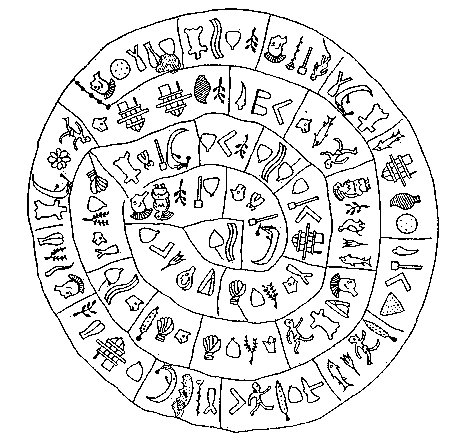
|
1 |
2 |
3 |
4 |
5 |
6 |
7 |
8 |
9 |
10 |
|
2 |
4 |
5 |
5 |
5 |
4 |
3 |
3 |
4 |
5 |
|
2 |
6 |
11 |
16 |
21 |
25 |
28 |
31 |
35 |
40 |
|
19 |
27¹ |
19 |
19 |
29 |
17 |
19 |
12 |
27 |
29 |
|
16 |
10 |
10 |
18 |
19 |
18 |
16 |
18 |
10 |
19 |
| |
28² |
12 |
23 |
32 |
10 |
19 |
19 |
28 |
32 |
| |
26 |
3 |
36 |
26 |
19 |
|
|
8 |
26 |
| |
|
9 |
34 |
30 |
|
|
|
|
30 |
|
2 |
4 |
5 |
5 |
5 |
4 |
3 |
3 |
4 |
5 |
 |
 |
 |
 |
 |
 |
 |
 |
 |
 |
|
11 |
12 |
13 |
14 |
15 |
16 |
17 |
18 |
19 |
20 |
 |
 |
 |
 |
 |
 |
 |
 |
 |
 |
|
21 |
22 |
23 |
24 |
25 |
26 |
27 |
28 |
29 |
30 |
|
1 |
2 |
|
19 |
16 |
27 |
10 |
28 |
26 |
|
breast |
flow |
canoe |
pole |
scarab |
|
 |
 |
 |
 |
 |
 |
|
1 |
2 |
3 |
4 |
5 |
6 |
|
→ Tea (Breast
Milk) |
→ Cradle |
|
|
|
... In the
morning of the world, there was
nothing but water. The Loon was
calling, and the old man who at
that time bore the Raven's name,
Nangkilstlas, asked her
why. 'The gods are homeless',
the Loon replied. 'I'll see to
it', said the old man, without
moving from the fire in his
house on the floor of the sea.
Then as the old man continued to
lie by his fire, the Raven flew
over the sea. The clouds broke.
He flew upward, drove his beak
into the sky and scrambled over
the rim to the upper world.
There he discovered a town, and
in one of the houses a woman had
just given birth. The Raven
stole the skin and form of the
newborn child. Then he began to
cry for solid food, but he was
offered only mother's milk. That
night, he passed through the
town stealing an eye from each
inhabitant. Back in his foster
parents' house, he roasted the
eyes in the coals and ate them,
laughing. Then he returned to
his cradle, full and warm. He
had not seen the old woman
watching him from the corner -
the one who never slept and who
never moved because she was
stone from the waist down. Next
morning, amid the wailing that
engulfed the town, she told what
she had seen. The one-eyed
people of the sky dressed in
their dancing clothes, paddled
the child out to mid-heaven in
their canoe and pitched him over
the side ...
|
I have here chosen to begin at the top so to say,
speculating that the breast could illustrate the Breast
of Cassiopeia (*8).
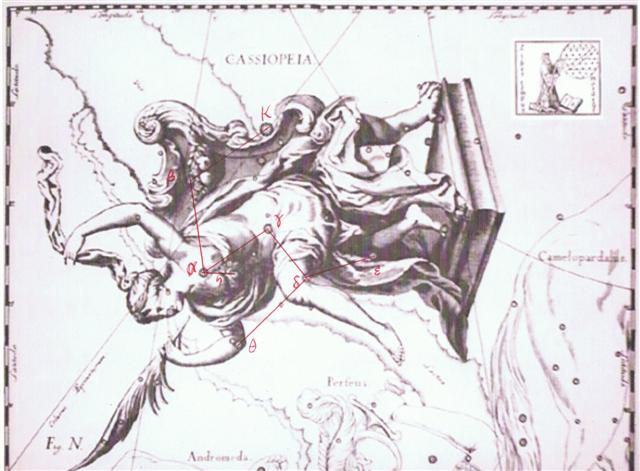
Counting 27 - 1 = 26 glyphs ahead from this point should then bring us to *8
+ *26 = *34
(*355 - *321).
|
19 |
7 |
|
19 |
16 |
19 |
|
breast |
flow |
breast |
 |
 |
 |
|
26 (*34) |
27 |
28 (→
*36 - *8) |
|
36 |
18 |
|
12 |
31 |
17 |
17 |
26 |
| |
female |
palace |
palace |
|
 |
 |
 |
 |
 |
|
65 (→
*73 - *8) |
66 |
67 |
68 |
69 |
|
... Hamiora Pio
once spoke as follows to the writer:
'Friend! Let me tell of the offspring of
Tangaroa-akiukiu, whose two daughters
were Hine-raumati (the Summer Maid -
personified form of summer) and
Hine-takurua (the Winter Maid -
personification of winter), both of whom
where taken to wife by the sun ... Now,
these women had different homes.
Hine-takurua lived with her elder
Tangaroa (a sea being - origin and
personified form of fish). Her labours were
connected with Tangaroa - that is,
with fish. Hine-raumati dwelt on
land, where she cultivated food products,
and attended to the taking of game and
forest products, all such things connected
with Tane ...
... Balancing the notion
of tapu, though not in perfect
dichotomy, is the notion of noa. This
pertains to mundane, ordinary objects and
functions - household and serving utensils,
the acts of preparing and eating food, the
many small and common interactions of
everyday life. Noa is safe - without
preternatural sanction or restricted
association, it is demonstrated by the
lifting of the condition of tapu from
a particular environment or object. A newly
built house, ornamented and fresh, would be
considered tapu - unsafe, prohibited,
raw with spirit and inaccessible to the
common touch of people. Making the place
noa - 'blessing' it in current terms -
would involve ritual, and the crossing of
the threshold, usually by a high-born woman
... |
|
19 |
*45 |
|
4 |
1 |
27 |
8 |
|
beginning |
8-petal flower |
canoe |
skin |
 |
 |
 |
 |
|
70 (→ *78 -
*8) |
71 |
72 (80 - 8) |
73 (→ *81) |
|
March 19 (158 - 80 |
θ Oct. (*364.4) |
SIRRAH (80) |
ALGENIB (*1) |
|
... Ecclesiastically, the
equinox is reckoned to be on 21 March (even
though the equinox occurs, astronomically
speaking, on 20 March [*364] in most years)
...
... The Symplegades
... or Clashing Rocks, also known as the
Cyanean Rocks, were, according to Greek
mythology, a pair of rocks at the Bosphorus that
clashed together randomly. They were defeated by
Jason and the Argonauts, who would have been
lost and killed by the rocks except for Phineus'
advice. Jason let a dove fly between the rocks;
it lost only its tail feathers. The Argonauts
rowed mightily to get through and lost only part
of the stern ornament. After that, the
Symplegades stopped moving permanently ... The
Argonauts, with the Golden Fleece on board, had
to pass the Symplegades, the clashing rocks.
Once a ship with its crew came through unharmed
- so the 'blessed ones' (makaroi) had
decided long ago - the Symplegades would stay
fixed, and be clashing rocks no longer.
After that 'accepting the
novel laws of the fixed earth', they should
'offer an easy passage to all ships, once they
had learnt defeat'. This is only one
station on the long 'opening travel' of the
Argonauts transporting the Golden Fleece (of a
ram), undertaken in all probability to introduce
the Age of Aries, but it demonstrates best the
relevant point, namely, 'the novel laws' ...
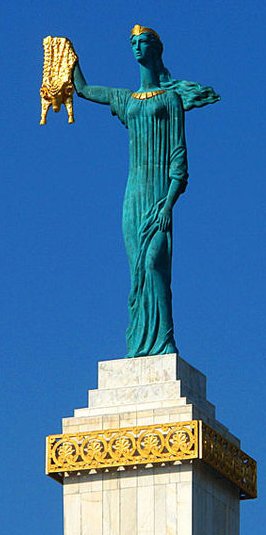 |
Thus my working idea is that the Breast at the top of the
female (night) side
of the disc ought to be at the opposite place as compared to the
Flower
of the male (daylight) side:
 . .
... The branches with their white flowers
bent down along their thighs, the double-headed ecliptic
snake rested in their arms, and the great bird Itzam-Yeh
stood on their head. I already knew as I stood under the
young tree in Tikal that the kings were the human embodiment
of the ceiba as the central axis of the world. As I stood
there gazing at the flowers in Joyce's hand, I also learned
that the kings embodied the ceiba at the moment it flowers
to yield the sak-nik-nal, the 'white flowers', that
are the souls of human beings. As the trees flowers to
reproduce itself, so the kings flowered to reproduce the
world ...
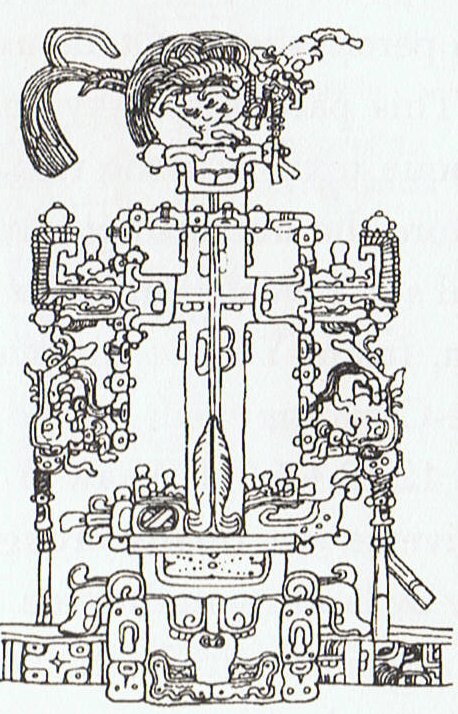
Schedir (the Breast, α
Cassiopeiae) should thus be visible in the night sky at
a place corresponding to March 29 (88, *8), when the Sun
had reached day *328 → 240 + 88:
|
PHAISTOS DISC |
|
top |
1 (*206) |
121 |
123 (*328) |
|
κ Octantis
(*206.4) |
NASHIRA
(*328.0) |
|
Ea5-16 (152) |
Ea8-18 → 81 * 8 = 648 |
|
bottom |
*8 (88) |
*116 |
*124 (204) |
|
March 29 |
July 23 |
|
SCHEDIR |
RAS ALGETHI
|
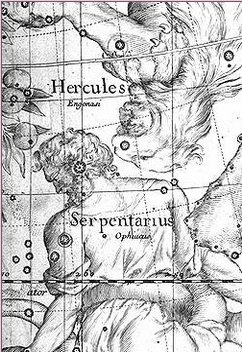
|
Schedir
(*8) |
Day of
culmination |
|
(80 + RA
/ 24h * 365¼) |
233 |
| Nov
18 (322) |
March 29
(88) |
|
132 + 233
= 365 days |
|
Betelgeuze (*88) |
Day of
culmination |
138 |
(80 + RA
/ 24h * 365¼) |
225 |
|
Jan 29
(121 + 3 * 91) |
June 17
(168 → 88 + 80) |
|
365 days
= 20 weeks + 15 * 15 days |
|
Thuban (*212) |
Day of
culmination |
133 |
(80 + RA
/ 24h * 365¼) |
230 |
|
June 7
(168 - 10) |
Oct 19
(292) |
|
135 + 230
= 365 days |
|
Zuben
Elgenubi (*224) |
Day of
culmination |
135 |
(80 + RA
/ 24h * 365¼) |
228 |
|
June 17
(168 → 204 - 36) |
Oct 31
(304) |
|
137 + 228
= 365 days |
|
Ras
Algethi (*260) |
Day of
culmination |
135 |
(80 + RA
/ 24h * 365¼) |
228 |
|
July 23
(204
→
158 + 46) |
Dec 6
(340 → 292 + 48) |
|
137 + 228
= 365 days |

|









 .
.

